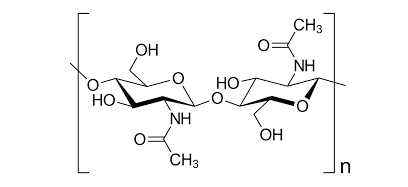
Insects need to replace the old cuticle with a new cuticle to metamorphose and mature. The cuticle is the outermost component of insects that covers all the external parts of the body of invertebrates. It is also present in small amounts in some internal parts of the body of insects. The cuticle consists of three layers:
epicuticle, exocuticle, and endocuticle. The structure of the exocuticle and endocuticle is chitinous, while the epicuticle contains less amount of chitin. It is estimated that about 20 to 50% of the dry weight of insect cuticle is from chitin.
Chemical formula: C8H13O5N)n)
Chitin is a long polymer of n-acetylglucosamine and a derivative of glucose, its name is derived from the ketone (a Greek word), which means hard coating.
Chitin molecular structure 
Chitin structurally is similar to cellulose, and is a structural polymer composed of glucose subunits connected by (β-(1 → 4) linkages. These bonds give strength to the whole structure. Chitin and cellulose are both made of glucose monomers but in cellulose, a hydroxyl group is attached to the cellulose monomer, while in chitin an acetylamine group is substituted. Functionally, chitin is most similar to the protein keratin.
Chemical formula: C56H103N9O3
Chitosan is a polysaccharide which described as a functional derivative of chitin. A polymer with 100% acetylated amine groups is called chitin and a polymer without amide groups (100% amine group) is called chitosan.
Conventionally, the presence of 50% of amide groups is considered as the boundary between chitin and chitosan. Chitosan is a non-toxic polymer with high absorbency. This material can be decomposed in nature and is completely compatible with the environment.
sources of chitin and chitosan
After cellulose, chitin is the most abundant polysaccharide in nature; it is found in the exoskeleton of crustaceans such as crabs and shrimps, the cell walls of fungi, the teeth of mollusks and fish scales, some amphibian scales, and in the cuticle of insects such as dark beetles.
Production of chitin from natural sources
The chitin extraction process includes two main steps: removal of minerals and deproteinization. Although the removal of minerals is considered a key step for the success of chitin purification, due to the low crude fiber content of mealworm (the amount of ash in the cuticle of the worm flour (3.7%) compared to the amount of ash in the exoskeleton and cuticle od other species is low) the efficiency of the mineral removal process is low and cannot justify a large amount of water used in this process and this step is usually skipped.